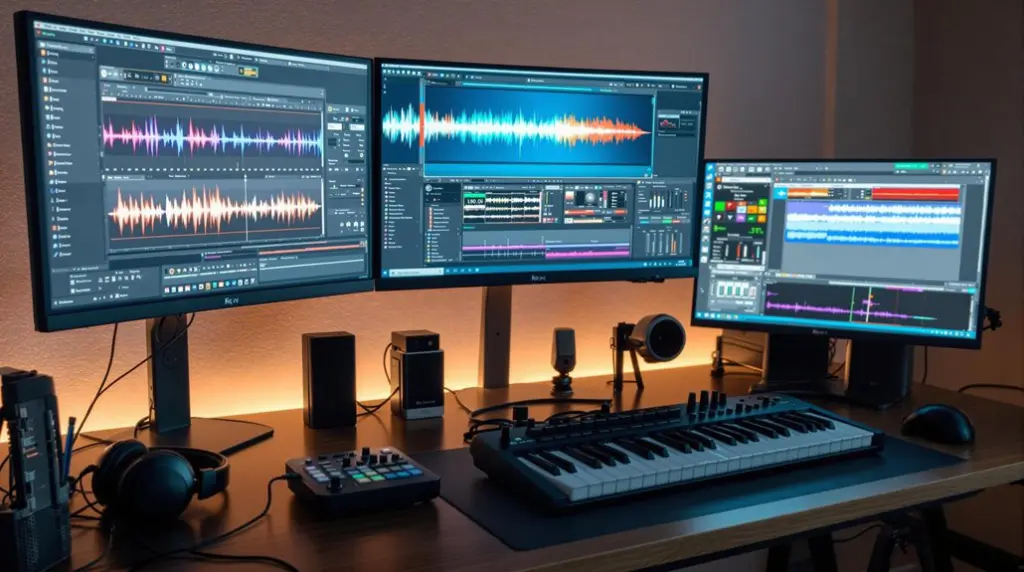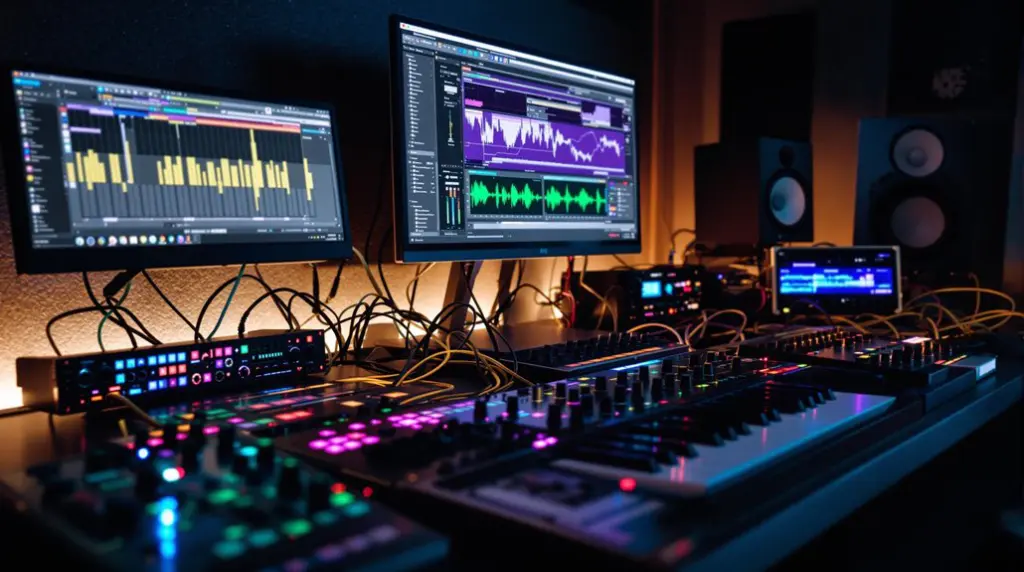When comparing Mackie and JBL studio monitors, three key aspects stand out: speaker size, driver technology, and frequency response range. Mackie offers models with woofer sizes suitable for small studios, emphasizing bass accuracy. JBL, on the other hand, excels with larger woofers that provide superior low-end extension. In regard to driver technology, Mackie’s silk-dome tweeters and polypropylene cones offer detailed audio, while JBL’s Image Control Waveguide enhances soundstage detail. Frequency response range shows Mackie prioritizing a mid-bass boost, whereas JBL provides a broader range with high-frequency clarity. To fully grasp these distinctions, you should look deeper.
Key Takeaways
- Mackie monitors excel in near-field monitoring with their 5-inch woofers, ideal for small studio spaces.
- JBL’s 8-inch monitors offer superior low-end extension and high sound pressure levels for larger studio environments.
- Mackie employs silk-dome tweeters and polypropylene cones for detailed audio and tight bass response.
- JBL’s Image Control Waveguide technology improves soundstage detail and accuracy.
- Mackie monitors have a frequency response range of 45Hz to 20kHz, while JBL monitors offer a broader range of 43Hz to 24kHz.
Speaker Size
When evaluating studio monitors, speaker size is a critical determinant of their frequency response, bass output, and overall sound pressure levels. Mackie and JBL offer studio monitors with varying woofer sizes, typically ranging from 5 inches to 8 inches, each catering to specific room size suitability and sound preferences.
Mackie’s studio monitors, particularly the smaller 5-inch models, are ideal for near-field monitoring. These models are well-suited for smaller studios or editing suites where the listener is positioned close to the speakers. The 5-inch woofers excel in providing detailed mid and high frequencies, though they may lack substantial low-end extension compared to their larger counterparts.
Conversely, JBL’s larger models, such as those with 8-inch woofers, are engineered to deliver significant low-end extension and greater sound pressure levels. These characteristics make them suitable for larger studio spaces or environments requiring robust bass output and high-volume capabilities, such as music production. The broader frequency response of JBL’s larger monitors ensures accurate reproduction of low-frequency content, enhancing sound clarity and detail.
Driver Technology
Driver technology plays a pivotal role in determining the overall performance and sound quality of Mackie and JBL studio monitors. Both brands leverage advanced engineering to optimize driver materials and sensitivity levels, ensuring superior sound reproduction.
Mackie studio monitors utilize custom waveguides paired with silk-dome tweeters. This combination enhances high-frequency clarity and dispersion, providing a precise and detailed audio experience. The silk-dome tweeters are known for their smooth, non-fatiguing response, making them ideal for prolonged listening sessions. Additionally, Mackie employs polypropylene cones in their woofers, which are renowned for their rigidity and lightness. These characteristics contribute to a tight and accurate bass response, essential for critical listening environments.
Conversely, JBL studio monitors feature Image Control Waveguide technology, which improves soundstage detail and imaging accuracy. This technology allows for a more immersive listening experience, essential for mixing and mastering applications. JBL’s advanced transducer designs incorporate sophisticated materials and engineering techniques to optimize frequency response while minimizing distortion. These transducers are meticulously crafted to achieve high sensitivity levels, translating to efficient power usage and robust sound output.
Frequency Response Range
Examining the frequency response range of Mackie and JBL studio monitors reveals differences in their ability to reproduce low and high-frequency sounds, ultimately impacting their suitability for various audio production tasks.
Mackie monitors typically offer a frequency response range of 45Hz to 20kHz, characterized by a smoother response with a slight boost in the mid-bass area. This design can enhance sound accuracy in bass-heavy genres, though it may necessitate precise EQ adjustments during mixing to maintain balance in other frequency bands.
Conversely, JBL studio monitors often feature a broader frequency response range of 43Hz to 24kHz, providing an extended high-frequency capability. This range, paired with a boost in the mid-high frequencies, facilitates a more analytical sound profile. Such characteristics are advantageous for detecting subtle details and imperfections in a mix, making JBL monitors ideal for intricate mixing techniques and critical listening environments.
Both brands offer solid bass response down to around 45Hz, making them suitable for various room acoustics. However, the choice between Mackie and JBL may ultimately depend on the specific audio production requirements, with Mackie favoring bass accuracy and JBL offering detailed high-frequency information.
Frequently Asked Questions
Are JBL Studio Monitors Good?
JBL studio monitors are highly regarded for their superior audio clarity and robust build quality. Their wide soundstage and detailed midrange clarity, combined with cost-effectiveness, make them an excellent choice for professional and home studios alike.
Does Mackie Make Good Speakers?
Mackie has a long history of producing high-quality speakers known for their durability and exceptional sound performance. Their studio monitors are highly regarded for providing balanced, detailed audio, making them a reliable choice for professional applications.
Conclusion
In comparing Mackie and JBL studio monitors, key features such as speaker size, driver technology, and frequency response range were analyzed. Both brands offer distinct advantages in these areas, with Mackie providing robust driver technology and JBL excelling in frequency response.
Speaker size considerations also varied, impacting overall performance. The analysis reveals that the selection between Mackie and JBL should be based on specific studio requirements and preferences, as both brands deliver high-quality audio solutions.




